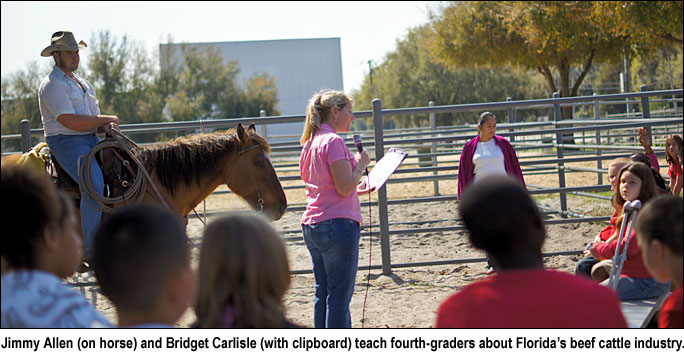| Agri-Fest: Where kids see and experience Florida’s cattle industry firsthand |
Seeing a cowboy, holding a bullwhip, learning about cows in Florida — at first, it might sound like the topics at-hand for local fourth-graders attending the beef station at this year’s Agri-Fest are more fit for a western fictional tale than academics, but what these students are learning couldn’t be closer to reality. [emember_protected custom_msg=”Click here and register now to read the rest of the article!”]
“The beef industry is important because it has been an integral part of Florida, being the first agriculture industry in the state,” says Bridget Carlisle, extension agent at the UF/IFAS Polk County Extension office and main speaker at the beef station. “We are teaching our future decision-makers for Florida about how the cattle industry helps the economy as well as preserves the environment.”
One of eight stations
Celebrating its 25th anniversary this year, Agri-Fest has sought each year to educate fourth-graders in Polk County on the different areas and benefits of the state’s agriculture industry.
From 8 a.m. to 12:30 p.m., students are engaged at different stations, which teach them about the many different facets of Florida agriculture, including small farms, citrus, beef cattle, blueberries, bees, horticulture, forestry, phosphate, and soil and water conservation. At this year’s Agri-Fest, the Florida Department of Agriculture’s Viva 500 exhibit was also present for the kids to enjoy.
This year, the popular beef station at Agri-Fest is a 20-minute presentation that has a real rancher ride up on horseback and an interactive discussion about cattle production.
Inside the station
With 70 to 100 students for each of the four teaching sessions at the beef station, holding students’ attention while educating them on facts is what Bridget seeks to do with each presentation. The outside surroundings of the station, next to the cattle pins, help visually introduce the beef industry to children, as does local rancher Jimmy Allen riding up on horseback to talk about Florida ranching. Jimmy even allows the students to hold the cow whip he uses on his ranch and demonstrates cracking the whip.
“We try to show them that after several hundred years, the cattle industry is still necessary to our whole economy, especially in Florida. This station allows students to not just read about the industry in textbooks but see it in real life before their eyes,” says Allen, in his eighth year of volunteering at Agri-Fest.
Bridget also comes armed with a table of everyday items, from a baseball mitt to laundry detergent, that contain cattle by-products and a historical presentation of the cattle industry in Florida, dating back to Ponce de Leon’s arrival, to show the long-term impact of the industry.
“Seeing the cowboy, his physical presence, is exciting to the students, as is seeing the cattle in the pins. Teachers like our station because we touch on the history of Florida and the cattle industry, which they are currently learning,” Bridget says.
As for Bridget and Jimmy, just seeing the enjoyment on the students’ faces as they learn new facts about their state is the biggest reward for their hard work. “This year is special because one of the groups will have my fourth-grade daughter in it. I will be there the day she will see the exhibit, so I will enjoy teaching her as well as the other kids,” Jimmy says. “It’s neat to know you taught them something they didn’t know before,” Bridget continues, “seeing the ‘a-ha’ moments from the kids when they realize a new fact about cattle.”
CREDITS
story by BLAIR TOWNLEY; photo by JUSTIN RHEINER [/emember_protected]

